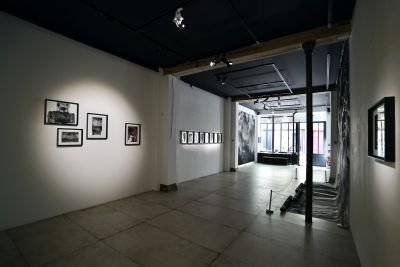Charcoal: in choosing this title for her new exhibition at Loo & Lou Gallery, Lydie Arickx is not only referring to the material that inspired some of the works on display, but also to a deeper interweaving of memories that seems to be woven together like the past sediments of her own life. Doesn't coal refer to that dark country dotted with slag heaps, peopled with memories of mines and corons, particularly in the north of France, where his family still has deep ties? Doesn't it also evoke images of shameful atavism, child labor and the "black faces" of Germinal, silicosis, the cries of miners' wives and the blasts of firedamp? Hasn't it served as fuel for a whole imaginary world of social revolt, that of a people who "thunder in their crater", rising up like an underground force, and will soon shatter the earth? By summoning this ore laden with all these fragments of human and plant life - coal being no more than an extract of fossilized trees and plants compressed in the viscous night of this region's subsoils - Lydie Arickx also continues her exploration of the arborescence of the living, while drawing on the mystical depths of Flemish painting.
By going to the coalface, Lydie Arickx is not afraid of dealing with a material that is not only tainted by the dirt of anthracite, but also demonized by its responsibility for global warming. The artist, no stranger to the art of systematic bricolage, even confides her wonder at this new ingredient likely to enrich her laboratory of plastic experimentation. Lydie Arickx has long been a devotee of "wild thought", which Claude Lévi-Strauss described as "the inscription, in the pictorial world, of techniques considered inadequate, unacceptable and unprofessional". Hasn't she always resorted to the most unorthodox materials, totally alien to the rules of academic painting?
It was in an impromptu way, using its medicinal virtues, that she discovered the full aesthetic potential of this vegetable charcoal. By mixing it with water, it diffuses on contact with the paper and spreads out in a multitude of unexpected graphic gesticulations, drawing a venous network with gnarled ramifications that are as organic as they are magical.
Here, the artist finds a new way to realize the dream of an informal expressionism: that of a material without form, without framework and without corset; similar to the lianascence of certain Caribbean plants, whose extreme versatility lends itself to all transformations and deformations, indefinitely malleable. Lydie Arickx enriches this substance, sometimes mixing it with pigments and acrylic resin.
Like a Füssli watercolor revisited by the "turbulent infinity" of Henri Michaux's mescaline drawings, evanescent and tenuous silhouettes fade in and out of view, lending the works the in-between quality of dream and fantasy. With its depth of black and remarkable matte finish, doesn't this charcoal evoke that "work in black" that would have made the greatest alchemists dream? Doesn't it embody the power to transmute values, bringing beauty out of the dark, impure depths of the vilest materials?
By restoring to the great flow of life the most sordid and apparently repugnant parts of existence, Lydie Arickx's art seems to be permeated by a song of desire that is reminiscent of the lyricism of certain pages by Henri Miller: "I love everything that flows: rivers, sewers, lava, (...) all the pus and filth that as it flows purifies itself, everything that loses the sense of its origin, everything that travels the great circuit towards death and dissolution. "
Hence, no doubt, this tendency to "add another layer", with this yellow face in particular, with its impasto of materials giving the painting the appearance of a veritable "bas-relief" of "material" glory.
So, by perpetually enriching the variety of materials in her plastic vocabulary, isn't the artist inventing a language open to the gaping holes of life, in the same way that Hugo drew the illuminations of his poetry from the "Mouth of Shadow"? Because for the painter, as for the poet, isn't it above all a matter of knowing how to "contemplate"?
Less than a creator of forms, the artist becomes a revelator, a "tool" for revealing the virtual properties of a material. Just as a child marvels at seeing his or her own drawing, so is he or she astonished by the emergence of forms forever in the making?
Lydie Arickx's works are fully part of an aesthetic of play. To appreciate them, we should no doubt draw inspiration from the famous passage in Leonardo's Notebooks entitled "A way of stimulating and awakening the intellect for various inventions", and the "walls smeared with stains" from which "an infinity of things are born that you will be able to reduce to distinct and well-conceived forms".
Thus, from limbo, and from the lineaments of a wash, a couple of embracing figures seem to tenderly form as the ink meanders.
By placing Lydie Arickx's work under the Duchampian banner, could we not say, at last, that in this exhibition, "it is (also) the viewers who make the painting"?
- Philippe Godin, Art critic










